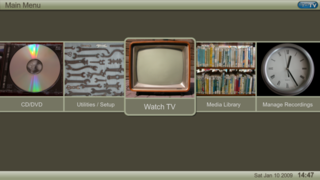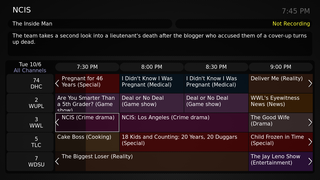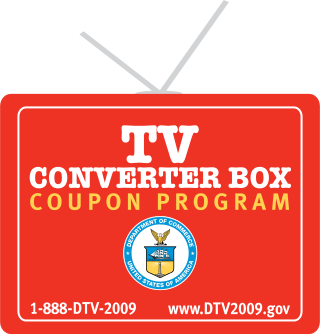Related Research Articles

TiVo Corporation, formerly known as the Rovi Corporation and Macrovision Solutions Corporation, was an American technology company. Headquartered in San Jose, California, the company is primarily involved in licensing its intellectual property within the consumer electronics industry, including digital rights management, electronic program guide software, and metadata. The company holds over 6,000 pending and registered patents. The company also provides analytics and recommendation platforms for the video industry.

TiVo is a digital video recorder (DVR) developed and marketed by Xperi and introduced in 1999. TiVo provides an on-screen guide of scheduled broadcast programming television programs, whose features include "OnePass" schedules which record every new episode of a series, and "WishList" searches which allow the user to find and record shows that match their interests by title, actor, director, category, or keyword. TiVo also provides a range of features when the TiVo DVR is connected to a home network, including film and TV show downloads, advanced search, online scheduling, and at one time, personal photo viewing and local music playback.
A DVD player is a device that plays DVDs produced under both the DVD-Video and DVD-Audio technical standards, two different and incompatible standards. Some DVD players will also play audio CDs. DVD players are connected to a television to watch the DVD content, which could be a movie, a recorded TV show, or other content.

In a raster scan display, the vertical blanking interval (VBI), also known as the vertical interval or VBLANK, is the time between the end of the final visible line of a frame or field and the beginning of the first visible line of the next frame or field. It is present in analog television, VGA, DVI and other signals.
A digital video recorder (DVR) is an electronic device that records video in a digital format to a disk drive, USB flash drive, SD memory card, SSD or other local or networked mass storage device. The term includes set-top boxes with direct to disk recording, portable media players and TV gateways with recording capability, and digital camcorders. Personal computers are often connected to video capture devices and used as DVRs; in such cases the application software used to record video is an integral part of the DVR. Many DVRs are classified as consumer electronic devices; such devices may alternatively be referred to as personal video recorders (PVRs), particularly in Canada. Similar small devices with built-in displays and SSD support may be used for professional film or video production, as these recorders often do not have the limitations that built-in recorders in cameras have, offering wider codec support, the removal of recording time limitations and higher bitrates.
A broadcast flag is a bit field sent in the data stream of a digital television program that indicates whether or not the data stream can be recorded, or if there are any restrictions on recorded content. Possible restrictions include the inability to save an unencrypted digital program to a hard disk or other non-volatile storage, inability to make secondary copies of recorded content, forceful reduction of quality when recording, and inability to skip over commercials.

MythTV is a free and open-source home entertainment application with a simplified "10-foot user interface" design for the living room TV. It turns a computer with the necessary hardware into a network streaming digital video recorder, a digital multimedia home entertainment system, or home theater personal computer. It can be considered a free and open-source alternative to TiVo or Windows Media Center. It runs on various operating systems, primarily Linux, macOS, and FreeBSD.

Copy Control was the generic name of a copy prevention system, used from 2001 until 2006 on several digital audio disc releases by EMI Group and Sony BMG Music Entertainment in several regions. It should not be confused with the CopyControl computer software copy protection system introduced by Microcosm Ltd in 1989.

D-VHS is a digital video recording format developed by JVC, in collaboration with Hitachi, Matsushita, and Philips. The "D" in D-VHS originally stood for "Data", but JVC renamed the format as "Digital VHS". Released in December of 1997, it uses the same physical cassette format and recording mechanism as S-VHS, but requires higher-quality and more expensive tapes and is capable of recording and displaying both standard-definition and high-definition content. The content data format is in MPEG transport stream, the same data format used for most digital television applications. It used MPEG-2 encoding and was standarized as IEC 60774-5.

Electronic programming guides (EPGs) and interactive programming guides (IPGs) are menu-based systems that provide users of television, radio and other media applications with continuously updated menus that display scheduling information for current and upcoming broadcast programming. Some guides also feature backward scrolling to promote their catch up content. They are commonly known as guides or TV guides.
Copy Generation Management System – Analog (CGMS-A) is a copy protection mechanism for analog television signals. It consists of a waveform inserted into the non-picture vertical blanking interval (VBI) of an analogue video signal. If a compatible recording device detects this waveform, it may block or restrict recording of the video content.
The Nextcom R5000-HD is a popular Windows-based system for digitally capturing HD (high-definition) and SD (standard-definition) TV content from satellite TV and cable TV sources. A modification is required to the set-top box, giving it a USB 2.0 output that is connected to a PC. The digital video recorder (DVR) and companion personal video recorder (PVR) software runs on any Windows 2000, Windows XP, Windows 7 and Windows 10 system and can record just about any content to hard disk or D-VHS tape. Programming can be encoded in MPEG-2, or MPEG-4 type AVC/H.264 formats. MPEG transport streams compliant with the ISO 13818-1 specification are created.
TiVo digital video recorders encompass a number of digital video recorder (DVR) models that TiVo Corporation designed. Features may vary, but a common feature is that all of the units listed here require TiVo service and use its operating system.
The Protected Media Path is a set of technologies creating a "Protected Environment," first included in Microsoft's Windows Vista operating system, that is used to enforce digital rights management protections on content. Its subsets are Protected Video Path (PVP) and Protected User Mode Audio (PUMA). Any application that uses Protected Media Path in Windows uses Media Foundation.
This is a comparison of digital video recorder (DVR), also known as personal video recorder (PVR), software packages. Note: this is may be considered a comparison of DVB software, not all listed packages have recording capabilities.

A coupon-eligible converter box (CECB) was a digital television adapter that met eligibility specifications for subsidy "coupons" from the United States government. The subsidy program was enacted to provide terrestrial television viewers with an affordable way to continue receiving free digital terrestrial television services after the nation's television service transitioned to digital transmission and analog transmissions ceased. The specification was developed by the National Telecommunications and Information Administration (NTIA), with input from the broadcast and consumer electronics industries as well as public interest groups.

A cable converter box or television converter box is an electronic tuning device that transposes/converts channels from a cable television service to an analog RF signal on a single channel, usually VHF channel 3 or 4, or to a different output for digital televisions such as HDMI.
Analog passthrough is a feature found on some digital-to-analog television converter boxes. Boxes without the analog passthrough feature only allow older, analog-only TVs to view digital TV. Those with analog passthrough allow both digital and analog television to be viewed on older TVs.
The analog hole is a perceived fundamental and inevitable vulnerability in copy protection schemes for noninteractive works in digital formats which can be exploited to duplicate copy-protected works using analog means. Once digital information is converted to a human-perceptible (analog) form, it is a relatively simple matter to digitally recapture that analog reproduction in an unrestricted form, thereby fundamentally circumventing any and all restrictions placed on copyrighted digitally distributed work. Media publishers who use digital rights management (DRM), to restrict how a work can be used, perceive the necessity to make it visible or audible as a "hole" in the control that DRM otherwise affords them.
AllVid was a proposal to develop technology enabling smart broadband-connected video devices to access the content on the managed networks of cable operators, telcos, and satellite-TV operators. It was initially proposed in the U.S. Federal Communications Commission's (FCC) National Broadband Plan in 2010. The AllVid hardware would act as a universal adapter for all types of pay TV content such as video-on-demand and pay-per-view, as well as interactive programming guides, delivered through a wide variety of means, including cable TV, satellite TV, VDSL, IPTV, and Internet TV.
References
- ↑ "TiVo's support page concerning copy protection". Archived from the original on 2012-07-16.
- ↑ "Charter's support page concerning copy protection". Archived from the original on 2013-06-02. Retrieved 2013-06-07.
- ↑ "FCC Plug and Play agreement" (PDF). Archived from the original (PDF) on 2011-02-10. Retrieved 2012-06-21.
- ↑ "The Coax Straightjacket: Stopping Cable Copy-Protection Abuse". Archived from the original on 2012-07-12.